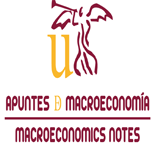
Until now we have considered that investment (I) is a constant value, which is given in the economy, that is, we have considered that I is equal to autonomous investment ( ). However, we are now going to consider that I depends on the interest rate. Thus, we define the investment function as the relationship between investment and the interest rate. In order to invest, we can assume that companies borrow money that must be repaid with interest. Therefore, as interest rates are higher, companies will want to borrow less money, as the cost of borrowing money will be higher. Alternatively, we can assume that the company can finance itself and use its own money to make its investments. In this case, the interest rate can be considered an opportunity cost, since, instead of investing, the company could take the money and lend it to third parties, thus charging interest. The higher the interest, the more the company will earn from lending its own money, and the less willing it is to use it to finance its investments. Thus, if the interest rate rises, investments will fall.
Even so, companies may invest more, or less, depending on other circumstances. For example, from the expectations of their business. If companies think that the business they are going to do is very good, they will be willing to invest more, regardless of how high or low the interest is.